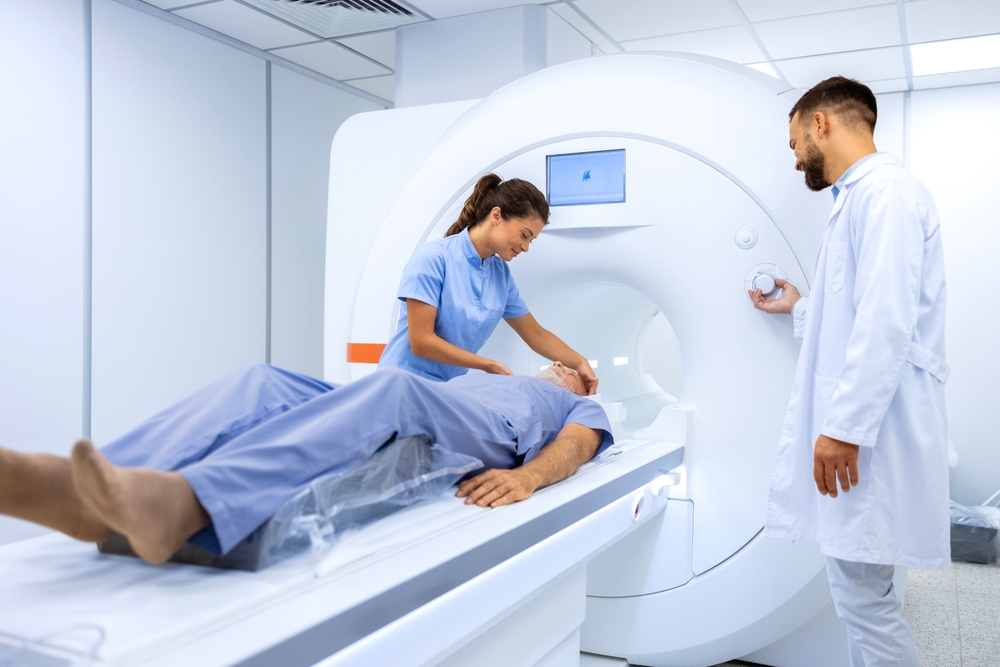Radiation therapy is frequently part of a multi-modality treatment plan for malignant mesothelioma. Radiation therapy is not an invasive procedure, but it does have potential side effects. Knowing how to prepare and how to manage potential side effects will help you through your treatment journey.

Understanding Radiation Therapy’s Role in Treating Malignant Mesothelioma
Radiation therapy uses high-energy rays to target and destroy cancer cells. For patients diagnosed with malignant mesothelioma, it is generally used as part of a multimodality treatment approach in combination with surgery and chemotherapy. Radiation therapy is an effective way of shrinking tumors before surgery (neoadjuvant therapy) as well as killing any remaining cancer cells after surgery (adjuvant therapy). It can also help reduce pain and discomfort and improve patients’ quality of life (palliative therapy).
Before Treatment Begins
Your radiation therapy treatment will begin with a medical evaluation to answer the radiation oncology team’s specific questions. In addition to conducting a thorough physical examination and review of your medical history, the team will conduct a simulation session to determine the best positioning of your body that will be used for each treatment. You’ll be given specific instructions on how to prepare for this simulation appointment. These instructions may include:[1]
– Following a bowel preparation protocol to empty your intestines
– Keeping your bladder full or empty
– Following specific dietary guidelines, such as fasting after a certain time
– Taking certain medications beforehand
– Learning and practicing breathing techniques
– Practicing holding still or positioning your arms above your head
During the simulation session, the care team will use special positioning devices to help keep you still and comfortable. You’ll undergo detailed imaging scans which may include CT, MRI, or PET scans to guide your doctors in creating a precise map of your treatment area. They may tattoo tiny permanent marks on your skin to help ensure that each future treatment focuses on the exact same spot on your body with the pinpoint accuracy needed for the treatment to be effective.[1]
Preparing for Your Radiation Therapy Treatment
Everybody responds differently to radiation therapy: Some mesothelioma patients may experience minimal side effects while others may have more pronounced discomfort. The side effect most frequently associated with radiation therapy is fatigue, which can range from mild tiredness to profound exhaustion. It’s also common for the skin in the treated area to become red and irritated as if you’ve been sunburned, and your skin may eventually peel. Any hair in the treatment area might thin or fall out, and radiation directed at the chest or abdomen can cause nausea, vomiting, or diarrhea. These effects generally improve gradually once treatment is complete.
Get Plenty of Rest
Radiation can make you tired to the point of extreme fatigue. Try to get a good night’s sleep before each session, and don’t be shy about asking friends and family for help when you need it. During your treatment period, plan to take a nap or do something relaxing whenever you can, and don’t try to overdo it.
Because fatigue is so common following radiation therapy, it’s a good idea to stock up on easy-to-prepare, nutritious meals that you can reheat quickly without much effort. It’s a good idea to freeze these in disposable containers so you don’t need to wash dishes. If possible, arrange to have help with other household chores.
To make yourself as comfortable as possible, create a comfortable area in your home where you’ll be able to curl up, doze off, and have everything you need at hand. You should also pull out any loose-fitting, soft clothing so that you don’t have to go searching for it. Having it readily available for you to slip into will be helpful.
Lifestyle Adjustments
If you smoke cigarettes, stopping before beginning radiation therapy would be very helpful, as smoking can reduce treatment effectiveness. Try to maintain good nutrition to keep your energy up.
Eat a Balanced and Nutritious Diet
Your body will need proper nutrition during radiation therapy. Speak with your care team’s dietitian for help with an appropriate meal plan, and don’t take supplements or vitamins without approval from your doctor.
Before Each Mesothelioma Radiation Therapy Session
When getting ready to go to your mesothelioma radiation therapy session, follow whatever instructions you’ve been given regarding food, drink, and emptying your bladder or keeping it full. Choose comfortable clothing and shoes that are easy to take off and leave your jewelry at home as you will not be allowed to wear it when you’re being imaged and treated.
You may want to pack a bag to bring with you for radiation each day. Some days there will be longer than others. Be sure to bring a robe and something to read, or in some other way, keep yourself occupied, as it is not unusual to end up waiting for long stretches before your treatment begins.
Items you may want to bring with you are:[1]
- A robe to go over your gown
- Non-slip socks or easy slip-on shoes
- A book or magazine to read.
- Snacks and water
- A notepad and pen so you can take notes from your meeting with your care team
- Essential oils, stress balls, or other items to help you relax
Managing Side Effects
Side effects of radiation therapy vary by person and treatment area. Common side effects include:
Skin Sensitivity
Because it absorbs small amounts of energy with each dose of radiation therapy, it’s common for the skin over the area being irradiated to become very sensitive. Roughly two to three weeks after your first treatment, your skin may become itchy, dry, or sore, and you may begin to notice redness and/or irritation that looks like a sunburn. Your team will monitor your skin to see whether you need to stop briefly to allow the skin to heal. If the reaction becomes severe, you may need special care.
To prepare for this side effect, patients undergoing radiation therapy should take special care to protect and care for their skin. You can do this by:[2]
- Keeping your skin clean and dry
- Wash skin in the treatment area with lukewarm water and a mild soap. Avoid using anything rough like washcloths or loofahs. Instead, gently use the palm of your hand and your fingertips.
- Dry skin gently. Pat, don’t rub, using a soft towel.
- Moisturizing the skin can reduce itching and soften the skin, making you more comfortable. Talk with your radiation team about which moisturizer you should use. Do not use skin products that contain scents or perfumes.
- Wear loose-fitting, soft clothing over the treatment area
- Avoid anything that could cause injury to the skin in the area being treated
- Do not scratch your skin.
- Avoid using adhesive tape in the treatment area. If you need to bandage the area, use paper tape and try to apply it outside of the treatment area.
- Don’t use cornstarch or powders in the treatment area, as they can accumulate and lead to fungal infections.
- Don’t use heating pads, hot water bottles, or ice packs on the treatment area.
- Practice sun safety. No matter the season, stay in the shade and wear protective clothing including long sleeves, pants, and a hat when outdoors. Avoid the sun during peak hours (10 am to 2 pm). If you must go out in the sun, wear sunscreen with an SPF of at least 30, including the treatment area if your care team says it is allowed.
- Talk to your treatment team before swimming, including chlorinated pools, hot tubs, and non-chlorinated water like lakes, streams, or the ocean.
- Check the skin in the treatment area daily. Report any cuts, open areas, or changes to your radiation oncology treatment team.
- Use gentle detergents like Woolite, Ivory Snow, or Dreft to wash your clothes.
Most important of all, don’t apply anything to the area without checking with your radiation team first. Minor skin reactions caused by radiation therapy don’t generally need special treatment, but they should be brought to the attention of your team. If they become worse, your radiation oncologist may decide to pause treatment to let the skin heal.[2]
Fatigue
Though doctors don’t fully understand its cause, fatigue from radiation therapy is a common side effect. It typically begins shortly after treatment starts and gradually increases until the midpoint of therapy. From there, it generally remains steady until the completion of treatment.
To manage radiation therapy fatigue, plan rest periods throughout the day and maintain a consistent sleep schedule. If possible, try to stay physically active, and allow your friends, family, and neighbors to help you with errands, chores, and cooking.
Difficulty Swallowing
Difficulty swallowing is a common side effect of radiation therapy when patients with pleural mesothelioma get radiation therapy. It’s caused by inflammation in the esophagus and usually lasts for seven to 10 days after the treatment has ended.
To manage these problems:[3]
- Cut food into small pieces and chew thoroughly or puree your food.
- Use gravy, sauces, broth, or milk to soften your food and make it easier to swallow.
- Drink sips of liquid between bites of food.
- Eat soft foods. Consider gelatin, yogurt, pudding, pasta, cooked vegetables, canned fruit, soft-cooked eggs, applesauce, cooked cereal, cottage cheese, ice cream, and sherbet.
- Cool, but not frozen, foods may be soothing.
- Let hot foods cool to room temperature.
- Avoid foods like nuts, crackers, dry cereal, and raw fruits and vegetables that may irritate your throat and esophagus.
- Avoid acidic citrus foods including oranges, grapefruit, lemons, limes, and tomatoes.
- Avoid spicy foods.
- Don’t use alcohol or tobacco.
- Choose toothpaste and mouthwash that doesn’t contain peroxide or alcohol.
- If you’re losing weight, ask your registered dietitian, nurse, or your doctor about nutritional supplements.
- If you have trouble swallowing pills, ask your nurse or pharmacist if it comes in liquid form or if you can crush the pills and take them with a teaspoon of ice cream or applesauce.
- Unless your doctor has restricted your fluids, drink six to eight glasses of fluids a day.
- Use lozenges, throat sprays, or other medications to help numb your mouth and throat, especially before meals and at bedtime.
- If you have pain medication prescribed, take it 30 minutes to one hour before you eat.
Shortness of Breath
Also known as radiation pneumonitis, shortness of breath after radiation therapy of the pleural area usually starts one to three months after treatment but can occur as long as 12 months after treatment. Treatment varies based on severity: Mild symptoms may resolve on their own without intervention, but if the condition is more severe, you may be prescribed steroids to reduce lung inflammation or supplemental oxygen.[4]
Loss of Appetite
During radiation therapy, you may lose your appetite or have a hard time eating well but maintaining a nutritious diet is essential for preserving your weight, boosting strength, managing side effects, and enhancing your response to treatment.[5]
If you’re struggling with loss of appetite, don’t wait to feel hungry. Eat small meals every couple of hours, setting an alarm to remind you. When you do have an appetite, eat as much as you can, and if you don’t feel like eating solid foods, try smoothies made with milk or milk powder, yogurt, fruit, and nut butters for extra protein. If cooking smells both you, ask someone else to prepare your food, or order in. Light physical activity such as walking may improve your appetite.[5]
If you’re struggling with nausea, try food and drinks with ginger or peppermint and sip water and other fluids throughout the day to prevent dehydration. Keep bland snacks like Saltines handy to settle your stomach, and if things don’t improve, ask your doctor if you can try anti-nausea medicine.[5]
Radiation therapy is part of most mesothelioma journeys. If you’re preparing for the treatment, remember that everybody is different and their experience with radiation therapy is unique. If you use this information as a general reference, you’ll be better prepared, but always follow the specific instructions provided by your healthcare team.
References
- Oncolink. (N.D.). Preparing for Radiation: Simulation and Treatment
Retrieved from: https://www.oncolink.org/oncopilot/preparing-for-radiation-simulation-and-treatment#:~:text=Before%20you%20start%20treatment%2C%20you,to%20map%20your%20treatment%20plan. - American Academy of Dermatology Association. (N.D.). How to care for your skin during and after radiation therapy.
Retrieved from: https://www.aad.org/public/diseases/skin-cancer/types/common/melanoma/radiation-care - UPMC Hillman Cancer Center. (N.D.). Managing Swallowing Problems From Radiation Therapy
Retrieved from: https://hillman.upmc.com/patients/community-support/education/radiation-therapy/managing-swallowing-problems - Oncolink. (N.D.). Radiation Pneumonitis.
Retrieved from: https://www.oncolink.org/cancer-treatment/radiation/side-effects-of-radiation-therapy/radiation-pneumonitis - Cancer Council NSW. (N.D.) Appetite loss and nausea.
Retrieved from: https://www.cancercouncil.com.au/cancer-information/cancer-treatment/radiation-therapy/side-effects/appetite-loss-and-nausea/

Terri Heimann Oppenheimer
WriterTerri Oppenheimer has been writing about mesothelioma and asbestos topics for over ten years. She has a degree in English from the College of William and Mary. Terri’s experience as the head writer of our Mesothelioma.net news blog gives her a wealth of knowledge which she brings to all Mesothelioma.net articles she authors.

Dave Foster
Page EditorDave has been a mesothelioma Patient Advocate for over 10 years. He consistently attends all major national and international mesothelioma meetings. In doing so, he is able to stay on top of the latest treatments, clinical trials, and research results. He also personally meets with mesothelioma patients and their families and connects them with the best medical specialists and legal representatives available.


